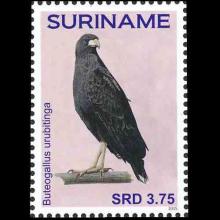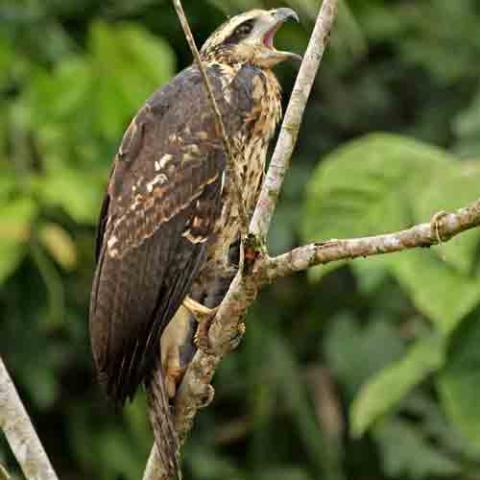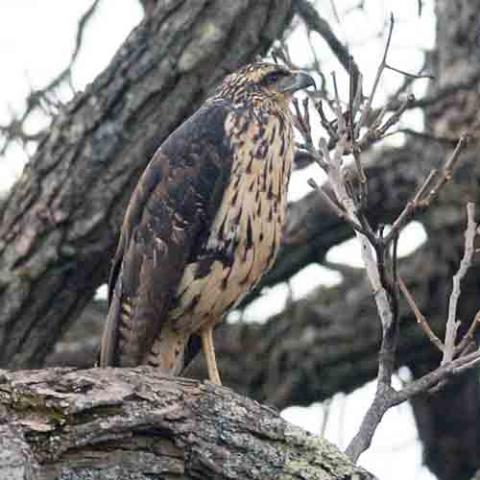NAMES
TAXONOMY
Suriname
Issued:
Stamp:
Buteogallus urubitinga
Suriname
Issued:
Stamp:
Buteogallus urubitinga
Suriname
Issued:
Stamp:
Buteogallus urubitinga
Clicking here will open a new page to xeno-canto.org with many great recordings of this bird: Buteogallus urubitinga (Great black hawk)
 Bill Nemitz: Maine wildlife chief no stranger to drama like the great black hawk flap
Bill Nemitz: Maine wildlife chief no stranger to drama like the great black hawk flap
A winter storm knocked the bird from its perch in Portland's Deering Oaks and a group of heroic souls came to the rescue.
Little did Judy Camuso know, back when Gov. Janet Mills nominated her to head the Maine Department of Inland Fisheries and Wildlife, that the question on everyone’s lips at her legislative confirmation hearing Wednesday will go something like this:
“Would the acting commissioner please articulate, both for the committee’s peace of mind and that of the people of Maine, what’s going to happen to the hawk?”
Camuso admitted in an interview Friday that she doesn’t yet know the answer. But, she conceded with a laugh, “I’m going to have to have one that’s acceptable.”
Maine’s one and only great black hawk, currently in the protective custody of the bird whisperers at Avian Haven (www.avianhaven.org), a rehabilitation hospital for all things feathered in the central Maine town of Freedom, has taken our winter lassitude by storm.
While its ever-growing multitude of fans waited breathlessly for the next update on Avian Haven’s Facebook page – Is it only one toe that’s frostbitten? Is it still eating its mouse “medallions”? – the young raptor continued to improve after almost freezing to death last Sunday in Portland’s Deering Oaks.
To recap: The hawk wandered away from its normal habitat in Mexico and Latin America last spring, flying first to Texas and then, during the summer, all the way to Maine.
Its arrival in August thrilled birders far and wide, the vast majority of whom had never before laid eyes on such a specimen. They flocked to its every sighting, cameras and binoculars in hand, until a winter storm knocked the bird from its perch in Deering Oaks and a cadre of heroic souls came to the rescue.
Enter Avian Haven, which for the past 20 years has treated some 26,000 birds from more than 100 species who arrive sick, orphaned, injured or any combination thereof.
“This afternoon, when (co-founder Marc Payne) opened the door of the Great Black Hawk’s hospital cage to replace provisions, the feisty bird jumped out and flew around the infirmary, landing on the exam table in the medical area,” read Thursday’s Facebook update. “So his afternoon check-up took place a little earlier than we had planned.”
Among the 150-plus comments that quickly piled up: “Is it too early to know what the chances are that you will be able to release him? If he can be released, will you do it up here or down in the warmer climate?”
The short answer is yes, it’s too soon to tell what effect the hawk’s frostbitten feet will have on its future travel plans. Once that’s known, according to Avian Haven, the decision on what to do next will be made in consultation with the Department of Inland Fisheries and Wildlife.
Which, sooner or later, will put the new commissioner squarely on the hot seat. Camuso has seen this kind of hubbub before.
For years, a lone red-billed tropicbird has inexplicably headed north each summer from its breeding area in the Galapagos Islands near the equator to a stretch of Maine coastal islands from Matinicus to Machias. “People love it. It’s got big, long tail streamers, a bright red bill. It’s a beautiful bird,” Camuso said, noting that when birders hop on the tour boats to go watch the terns, many are actually praying for a glimpse of the red-billed tropicbird.
Then there’s the ivory gull that years ago drifted south one winter from its Arctic habitat to Portland’s waterfront. Bird watchers swooped in and Camuso, who worked at the time for Maine Audubon, started showing up in the morning to prevent a mob scene.
She arrived one morning to see a man – he’d just driven all the way from Colorado – stumbling out of his car with his pants down around his ankles. Apparently, he’d been changing into or out of his long underwear and was afraid he’d miss the gull. “He was so panicked,” Camuso recalled. “He’d heard that the bird was there, so he got out of the car and was running across the parking lot in his undies, pulling his pants up as he went, shouting ‘Is the bird still here? Is the bird still here?’ ”
There’s a name for this kind of passion. It’s called “biophila,” a hard-wired affinity we humans have for other life forms. It explains everything from why we surround our homes with flowers and shrubs to why some of us go out of our way to save a cat in the tree or, in this case, a bird in the snow. Biophilia is in full bloom on Avian Havian’s Facebook page, right down to an emerging debate over whether the great black hawk should have a name.
Suggestions have ranged from “Parkside” to “Stan,” short for Stan Mikita, the legendary center for the Chicago Black Hawks, to “Mick Jagger, because of how he walks.”
To which one woman protested that this whole naming thing is way out of bounds.
“Naming a wild Relative seems like taking ownership of them.” she wrote. “This is where worldviews clash. Ownership is a colonial/imperial concept. It carries with it the notion that the Natural world is there to be controlled and used as one sees fit. Or put in a box to keep others out.”
I get her point. But honestly, who’s going to tell “Smokey” that, henceforth, he shall be referred to only as “the bear”?
Monikers aside, there’s not much we can do for now except cheer the hawk on and, if you’re so inclined, make a donation to Avian Haven online or by sending a check to Avian Haven, 418 N. Palermo Road, Freedom, ME 04941.
“The first part is to get the bird healed,” Camuso said. “My guess is no matter what happens, they’re not going to do anything with it until the spring.”
In the meantime, folks, let’s all keep our pants on.
Bill Nemitz can be contacted at: bnemitz@pressherald.com
Reference:
Genus species (Animalia): Buteogallus urubitinga
The great black hawk (Buteogallus urubitinga) is a bird of prey in the family Accipitridae, which also includes the eagles, hawks, and Old World vultures.
Taxonomy
The great black hawk was formally described in 1788 by the German naturalist Johann Friedrich Gmelin in his revised and expanded edition of Carl Linnaeus's Systema Naturae. He placed it with the eagles, hawks and relatives in the genus Falco and coined the binomial name Falco urubitinga. Gmelin's description was ultimately based on the "urubitinga" that had been described in 1648 by the German naturalist Georg Marcgrave in his Historia Naturalis Brasiliae. The great black hawk is now one of nine species placed in the genus Buteogallus was introduced in 1830 by the French naturalist René Lesson. The name genus is a portmanteau of Buteo, a genus introduced in 1779 by Bernard Germain de Lacépède for the buzzards and the genus Gallus introduced in 1760 by Mathurin Jacques Brisson for the junglefowl. The specific epithet urubitinga is from Tupi Urubú tinga meaning "big black bird" for such a raptor.
Two subspecies are recognized:
- Urubitinga ridgwayi (Gurney, JH Sr, 1884) – Mexico to west Panama
- Urubitinga urubitinga (Gmelin, JF, 1788) – east Panama to north Argentina
Description
The adult great black hawk is 56 to 64 cm (22 to 25 in) long and weighs 1.1 kg (2 lb 7 oz). It resembles the common black hawk, but is larger with a different call and tail pattern. It has very broad wings, and is mainly black. The short tail is white with a broad black tip. The bill is black and the legs and cere are yellow.
The sexes are similar, but immature birds are dark brown above with spotting and streaks. Their underparts are buff with dark spots, and the tail has a number of black and dusky bars. The call of the great black hawk is a distinctive piping ooo-wheeeeee.
Distribution and habitat
The great black hawk is a resident breeding bird in the tropical New World, from Mexico through Central America to Peru, Tobago and northern Argentina. It is a mainly coastal bird, but also lives in forests and open woodland near water.
Vagrancy
A great black hawk was first recorded in the ABA area on South Padre Island, Texas in April 2018. In August of that year the same individual, based on similarities in what is highly variable immature plumage, resurfaced in Biddeford, Maine. This individual was ranked as the #1 "Craziest Vagrant of 2018" by the ABA.
After disappearing for several months it reappeared in Deering Oaks park in Portland, Maine, where it remained a resident until being rescued during a snow storm on January 20, and transported to the bird rehab facility Avian Haven. The bird was euthanized on January 31 at Avian Haven due to extensive frostbite which prevented blood from reaching either leg or foot. In January 2020 it was mounted and is set to be displayed at the Maine State Museum.
Breeding
It builds a large stick nest in a tree, and usually lays one dark-blotched whitish egg.
Diet
The great black hawk feeds mainly on reptiles, other small vertebrates (such as amphibians, fish, birds, and small mammals), crabs, large insects, carrion, eggs, and fruits, often hunted on foot. This species is often seen soaring above woodlands. Along Amazon rivers it has been observed raiding hoatzin nesting colonies looking for eggs and chicks.
Reference: Wikipedia
Photo credits: Rolando Chavez, Roger Ahlman, Shawn Patrick Ouellette




